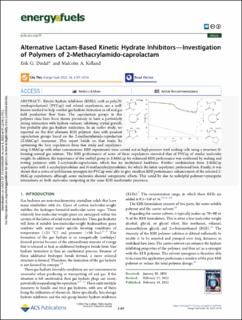| dc.contributor.author | Dirdal, Erik Gisle | |
| dc.contributor.author | Kelland, Malcolm Andrew | |
| dc.date.accessioned | 2023-01-20T08:47:59Z | |
| dc.date.available | 2023-01-20T08:47:59Z | |
| dc.date.created | 2022-04-08T09:08:52Z | |
| dc.date.issued | 2022 | |
| dc.identifier.citation | Dirdal, E. G., & Kelland, M. A. (2022). Alternative Lactam-Based Kinetic Hydrate Inhibitors─ Investigation of Polymers of 2-Methacrylamido-caprolactam. Energy & Fuels, 36(6), 3107-3118. | en_US |
| dc.identifier.issn | 0887-0624 | |
| dc.identifier.uri | https://hdl.handle.net/11250/3044824 | |
| dc.description.abstract | Kinetic hydrate inhibitors (KHIs), such as poly(N-vinylcaprolactam) (PVCap) and related copolymers, are a well-known method to help combat gas hydrate formation in oil and gas field production flow lines. The caprolactam groups in this polymer class have been shown previously to have a particularly strong interaction with hydrate surfaces, inhibiting crystal growth, but probably also gas hydrate nucleation. In an earlier study, we reported on the first alternate KHI polymer class with pendant caprolactam groups based on the 2-methacrylamido-caprolactam (2-MACap) monomer. This report builds on that study, by optimizing the best copolymers from that study and copolymerizing 2-MACap with other comonomers. KHI experiments were carried out in high-pressure steel rocking cells using a structure II-forming natural gas mixture. The KHI performance of some of these copolymers exceeded that of PVCap of similar molecular weight. In addition, the importance of the methyl group in 2-MACap for enhanced KHI performance was confirmed by making and testing polymers with 2-acrylamido-caprolactam, which has no methylated backbone. Further confirmation from 2-MACap copolymers with 1-acryloylpyrrolidine and N-methacryloylpyrrolidine, for which the latter copolymer performed best. Finally, it was shown that a series of well-known synergists for PVCap were able to give excellent KHI performance enhancement of the selected 2-MACap copolymers, although some molecules showed antagonistic effects. This could be due to unhelpful polymer–synergistic interactions or both molecules competing in the same KHI mechanistic processes. | en_US |
| dc.language.iso | eng | en_US |
| dc.publisher | ACS Publications | en_US |
| dc.rights | Navngivelse 4.0 Internasjonal | * |
| dc.rights.uri | http://creativecommons.org/licenses/by/4.0/deed.no | * |
| dc.title | Alternative Lactam-Based Kinetic Hydrate Inhibitors - Investigation of Polymers of 2‑Methacrylamido-caprolactam | en_US |
| dc.title.alternative | Alternative Lactam-Based Kinetic Hydrate Inhibitors - Investigation of Polymers of 2‑Methacrylamido-caprolactam | en_US |
| dc.type | Peer reviewed | en_US |
| dc.type | Journal article | en_US |
| dc.description.version | publishedVersion | en_US |
| dc.rights.holder | The author | en_US |
| dc.subject.nsi | VDP::Matematikk og Naturvitenskap: 400 | en_US |
| dc.source.pagenumber | 3107-3118 | en_US |
| dc.source.volume | 36 | en_US |
| dc.source.journal | Energy & Fuels | en_US |
| dc.identifier.doi | 10.1021/acs.energyfuels.2c00208 | |
| dc.identifier.cristin | 2016090 | |
| cristin.ispublished | true | |
| cristin.fulltext | original | |
| cristin.qualitycode | 2 | |

